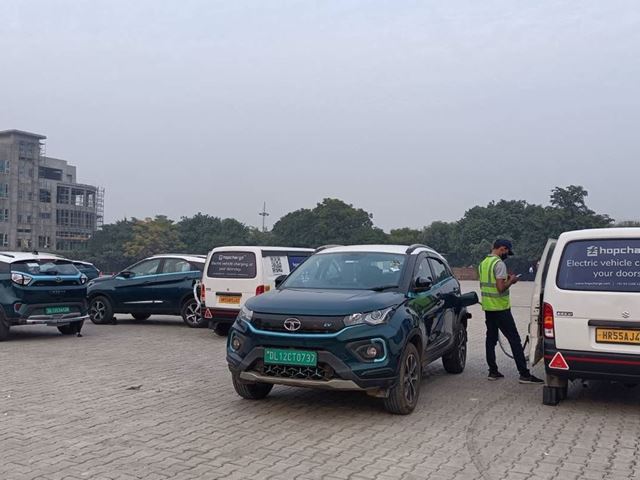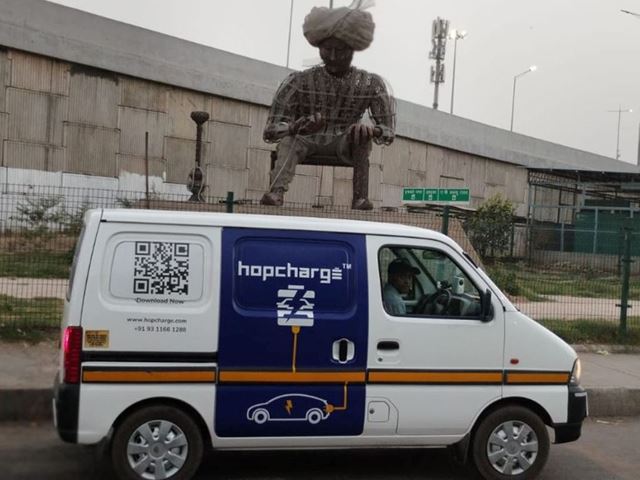Let’s start with an easy question. What are people most worried about when making the switch from an internal combustion engine (ICE) vehicle to an electric alternative?
Range anxiety is going to be high on the list, as is a lack of charging infrastructure. While this is true around the world, it is especially relevant for Indian drivers. However, Gurugram-based startup Hopcharge may have provided one solution by creating the world’s first on-demand electric vehicle (EV) charging service available on users’ doorsteps.
Co-founded by CEO Arjun Singh and CXO Saurabh Rohilla in 2019, Hopcharge has been making waves in the Delhi NCR region, where it launched earlier this year. Speaking to Auto Futures, Singh said: “We’ve only launched Hopcharge as a brand in the first quarter of this year. Prior to this, most of our effort for the last couple of years was focused on developing our product. It all started with an idea that revolved around an energy cloud. And while this may have many applications, we agreed that with the world moving towards electric mobility, what better use case than to use the concept of cloud-based energy systems to enable the area of electric mobility and have charging available to users on-demand and at their doorstep.”
“Today, Hopcharge is all about getting the energy delivered for electric cars, but in the future, it could be so much more than just that. When you think about it, a few decades back, people struggled to understand what a data cloud was. When you have a data cloud, you have large servers somewhere remote, and then you enable that data to the world. But that’s not how an energy cloud would work, because you definitely need the hardware to be close to the consumer and to be mobile, which is pretty much what Hopcharge does,” he added.
Both co-founders came with rich experience from relevant industries. Singh, a BITS Pilani alumnus, has had a successful career in the energy industry. Similarly, Rohilla, an IIT Delhi alumnus, brought in his expertise from the automotive industry. Together, they built a venture that has the potential to revolutionize the global electrification journey.

Way back in 2015, Singh was involved in the Government of Delhi Energy Policy initiative through the Delhi Development Commission. One important revelation from the initiative was that electricity infrastructure is very different from oil and gas. Oil and gas infrastructure is based on storage, whereas electric infrastructure is live. Oil and gas infrastructure has had almost a century to perfect its processes, but historically, the storage of electricity has been more challenging. While storing electricity has improved over the last five years, thanks to lithium-ion batteries, the problem is not completely solved.
However, there were other challenges. “We learned of two very important challenges,” said Singh.
“First off, the grid has a certain capacity that can’t be built overnight, or even over decades. This is why the UK had to pass legislation to ensure EV home and workplace chargers work with limited functionality at peak times to avoid blackouts, despite EVs having a market penetration of just 28.1% in the country.”
This challenge has a significant impact on Indian consumers, especially those living in apartment blocks. For starters, only select EV owners in apartment blocks can have their own home chargers, so the rest have to find chargers elsewhere. For the ones that are lucky enough to get a home charger, they’re looking at roughly 19-20 hours for a full charge if they have a 2kW charger, or 8-9 hours if they’ve managed to convince their Resident Welfare Association (RWA) to let them install a 7.5kW charger.
All told, the anxiety of running out of charge mid-journey always remains. And to combat this, Indian consumers have started looking at an additional ICE car, just to ensure that their choice to electric isn’t at the cost of their mobility. But then, was there any point in buying the EV in the first place?
“The second challenge we identified,” continued Singh, “was that electricity prices are regulated by the state governments through the regulator because every single dollar that goes into the distribution grid has to be recovered by the utility or the distribution company. This cost-plus model is applicable worldwide. And since this was pretty much controlled by governments, they delicensed the activity of charging so that private capital can be attracted to this domain. Otherwise, it’s very complex to get the money into distribution.”

When Hopcharge launched earlier this year, it was the only company in the world that served the on-demand doorstep charging space. Since its launch, the only other company in the world to follow a similar model is US-based startup SparkCharge. And while SparkCharge raised $23 million in May, with its first traction in July, it had to initially offer its services for free. Hopcharge, meanwhile, had a steady base of paying, subscribed users even then.
“What we did, honestly, is very simple,” explained Singh.
“Back in the day, when the phone batteries weren’t that great and would last only a few hours of intense use, people used to carry power banks. It was as simple as connecting your phone to the power bank with a wire to transfer energy and power up your phone. The process is pretty slow because there is no sophistication there. When it comes to EVs, however, they have to be charged quickly, or else the customer experience suffers. We simply connected the analogy of the power bank to a rapid charger. In essence, we made a big power bank and then made a rapid charger which integrates with it. And while the input is the power bank and the output is the electric car, it is now as efficient as a public fast charger. We built those capabilities in the interfaces between the power bank and the EV.”
When using Hopcharge, what people are essentially paying for is convenience and peace of mind. Previously, the company had a limited subscription plan, which offered a set number of charges, but they’ve now gone ahead and made that even simpler by introducing an unlimited alternative. With their unlimited subscription plan, users charge as many times as they like for INR 36,000 (around £360) each year. Hopcharge also offers a complimentary service of emergency rescue to their subscription holders, where they provide emergency charging assistance if one of their users’ cars were to run flat mid-journey.
Currently funded by a micro-institution at an angel/seed level, Singh says that Hopcharge is in talks with some private equity players. The company has been receiving a lot of national and international interest and is in serious talks to expand its reach across the globe. On the domestic front, OEMs too have been taking an active interest in Hopcharge, with some even inviting the company to sell from dealerships to address their potential customers’ range-related apprehensions.
“We now have more than 140 customers. Ours is a small-scale deployment. While we’re quite active in Gurgaon and parts of Delhi, we are not serving every part of NCR just yet. But the aim is to be rolling out more systems and being active across the NCR region by the next quarter. By early next year, we’re targeting to launch in three cities other than Delhi-NCR, and most possibly they are Mumbai, Bengaluru, and Chennai. The idea was to open up an early access program, where people across India can kind of enroll. Once the responses come in, we’ll analyze the data and make an informed decision,” said Singh.
“But one milestone that I’m very proud of is that we have successfully completed 500 doorstep EV charging sessions. That’s about 6.25 tons of CO2 savings, based on the India Grid Energy Mix. If you convert them to kilometers that we’ve powered, it is approximately 95,000 km. And this is just in the last 120-140 days. These numbers give us a strong belief that we did make a change for the better.”